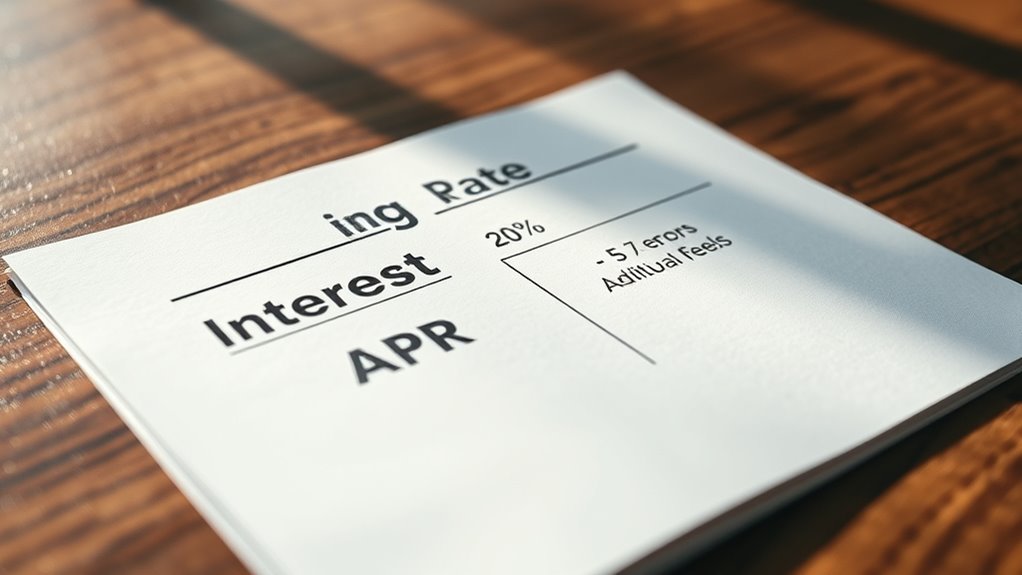The interest rate shows the basic yearly cost of borrowing, based only on the loan amount, while the APR includes interest plus all extra fees like origination, processing, and closing costs. This makes APR a more complete measure of your total borrowing expenses. If you want to compare loans accurately, understanding how APR reflects those additional costs is essential. Keep going to uncover the key differences that can help you make smarter borrowing decisions.
Key Takeaways
- The interest rate reflects only the annual borrowing cost, while APR includes interest plus additional fees and costs.
- APR provides a broader, more comprehensive measure of total loan expenses over time.
- Interest rate does not account for upfront fees, whereas APR incorporates origination, processing, and other charges.
- APR is useful for comparing loans with different fee structures, while interest rate shows the core cost.
- Relying solely on interest rate can be misleading; APR offers a clearer picture of total borrowing costs.
Defining the Interest Rate and APR

Understanding the difference between the interest rate and APR is essential when evaluating loans. The interest rate is the cost you pay annually for borrowing money, expressed as a percentage of the loan amount. It reflects only the basic cost of borrowing, without including fees or other charges. APR, or annual percentage rate, provides a broader view. It combines the interest rate with additional costs like origination fees, closing costs, and other charges, giving you a more all-encompassing picture of what you’ll pay yearly. This helps you compare different loan offers more accurately. While the interest rate shows the core cost, the APR accounts for the total borrowing expenses, making it a useful tool for understanding the true cost of a loan. Additionally, understanding heat pump technology can help you make more energy-efficient choices in home financing and upgrades.
How Each Term Reflects Borrowing Costs

The interest rate directly shows the yearly cost of borrowing the principal amount, making it a straightforward indicator of how much you’ll pay annually to lenders. It reflects the cost of the loan itself, expressed as a percentage, without including additional fees or costs. On the other hand, APR represents the total cost of borrowing over the loan’s duration, including interest and other fees. This makes APR a more all-encompassing measure of your borrowing expenses. While the interest rate helps you compare the basic cost of loans, APR gives you a clearer picture of what you’ll pay overall. Understanding this difference helps you evaluate loans more accurately, ensuring you’re comparing true costs rather than just interest rates alone.
The Components Included in APR

What factors contribute to the total cost reflected in APR? Your APR includes more than just the interest rate. It accounts for additional costs associated with borrowing, such as origination fees, loan processing fees, and sometimes points paid upfront to lower your rate. These fees are added to the interest rate to give a clearer picture of your total borrowing cost. If you’re taking out a mortgage, closing costs and mortgage insurance may be included. For personal loans or credit cards, annual fees or upfront charges can also be part of the APR calculation. By combining these costs, APR helps you compare different loan offers more accurately, showing the true expense of borrowing beyond just the interest rate. Additionally, Vetted – Halloween Product Reviews provide insights into various costumes and accessories, which can sometimes incur additional costs that may be reflected in the APR when financing such purchases. Understanding loan cost components can help you make better financial decisions when evaluating borrowing options. Recognizing the importance of the overall borrowing cost ensures you’re fully aware of what you’re paying. Moreover, considering payment processing fees is crucial, as they can significantly impact your total repayment amount, especially for online transactions or international payments. Knowing how interest rate calculations impact your total repayment can further enhance your financial literacy.
Situations Where APR Provides Better Clarity

APR offers clearer insights when comparing loan options that include various fees and costs. If you’re evaluating multiple loans, the APR helps you see the true cost beyond just the interest rate. It consolidates origination fees, closing costs, and other charges into a single percentage, making it easier to compare different offers objectively. This is especially useful when lenders present different fee structures or upfront costs. When shopping for a mortgage, car loan, or credit card, relying on APR ensures you’re not misled by low interest rates that mask hefty fees. By focusing on the APR, you gain a more accurate picture of what you’ll pay over the life of the loan, helping you make smarter financial decisions. Additionally, understanding Fokos can give you broader insights into financial concepts and tools that aid in making informed choices. Recognizing the difference between nominal interest rates and the effective interest rate is key to understanding the full financial implications, which the APR captures effectively. Incorporating cost comparison tools can further assist in evaluating the true affordability of different loan options, especially when considering the total cost of borrowing. Using the APR comparison approach helps consumers avoid hidden charges that could increase the overall cost unexpectedly.
Common Mistakes When Comparing Loan Offers

When comparing loan offers, it’s easy to fall into common pitfalls that can lead to choosing a more expensive option. One mistake is focusing solely on the interest rate without considering the APR, which includes fees and other costs. Another error is comparing loans with different repayment periods, skewing your perception of affordability. Additionally, some overlook variable versus fixed rates, risking unexpected increases. To avoid these pitfalls, consider these factors:
| Mistake | Impact | Solution |
|---|---|---|
| Ignoring fees | Underestimating total cost | Compare APRs, not just interest |
| Comparing different terms | Misjudging affordability | Use consistent loan durations |
| Overlooking rate types | Facing unexpected rate hikes | Clarify fixed vs. variable rates |
Being aware of potential security vulnerabilities in new payment technologies can help protect your financial data and prevent fraud. Staying informed about loan features and how they affect your total repayment can also prevent costly surprises. For example, understanding interest calculations can help you evaluate the true cost of a loan. Additionally, reviewing the terms and conditions thoroughly can ensure you are aware of all applicable fees and charges. Incorporating knowledge of lending practices and how they influence your choices can further safeguard your financial interests. Stay vigilant to make informed, cost-effective decisions.
Frequently Asked Questions
How Does APR Differ for Fixed Versus Variable Rate Loans?
When comparing fixed and variable rate loans, APR can differ because it includes the interest rate plus fees and other costs. For fixed-rate loans, the APR stays consistent throughout the term, reflecting the steady interest rate. With variable-rate loans, the APR can change as the interest rate fluctuates, potentially increasing your overall costs. Always review the APR carefully to understand your total borrowing expenses over time.
Can APR Change Over the Life of a Loan?
Yes, your APR can change over the life of your loan if it’s a variable or adjustable-rate loan. This is because the APR is tied to interest rates that fluctuate with market conditions. When rates go up or down, your APR adjusts accordingly, affecting your monthly payments and total cost. Keep in mind, fixed-rate loans typically maintain the same APR throughout their term.
Are There Types of Loans Where APR Isn’T Relevant?
You might wonder if there are loans where APR isn’t relevant. Typically, APR isn’t a key factor for short-term loans or certain secured loans, like auto or mortgage loans, where the interest rate and fees are straightforward. In these cases, lenders often focus on the interest rate itself. However, for personal loans or credit cards, APR helps you compare the true cost, so it’s usually relevant.
How Does Promotional or Introductory APR Impact Borrowing Costs?
Think of a promotional APR as a sparkling shortcut on your borrowing journey. It lowers your interest rate temporarily, making your initial costs feel lighter—like a flash of sunshine. But beware, once the promotional period ends, your rate can climb back up, increasing your overall borrowing costs. So, while it offers short-term relief, you should plan for the full picture to avoid surprises down the road.
Why Might Two Loans With the Same Interest Rate Have Different APRS?
You might notice two loans with the same interest rate but different APRs because APR includes additional costs like fees, closing costs, or insurance. These extra expenses increase the overall cost of borrowing, making the APR higher. So, even if the interest rates match, the total cost you pay over time can differ, helping you better compare the true expense of each loan.
Conclusion
Remember, understanding the difference between APR and interest rate is like choosing the right map for a journey. Just as a map shows more than the road—it highlights detours and shortcuts—APR reveals the full cost, including fees. When you compare loan offers, don’t just look at the interest rate; consider the APR to avoid surprises. It’s your guide to making smarter borrowing decisions, steering you clear of hidden costs and unnecessary expenses.









